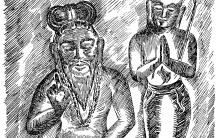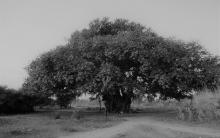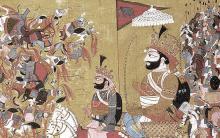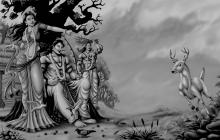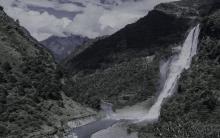In the earlier era, Vedic literature was one large body of wisdom with different ṛṣis having memorized different ṛks and mantras; different mantras had become scattered across different regions of the land. Had this situation continued, over a period of time there would have arisen a possibility of the Vedas getting destroyed; this would have resulted in an impediment to dharma and to culture.
Author:hari
Bṛhat-kathā-śloka-saṃgraha
ನಾನು ಮತ್ತೆ ಮತ್ತೆ ನೆನೆಯುವ ಮಹನೀಯರ ಪೈಕಿ ಶ್ರದ್ಧೇಯರಾದ ಲಂಕಾ ಕೃಷ್ಣಮೂರ್ತಿಯವರೂ ಒಬ್ಬರು. ಸತ್ಯನಿಷ್ಠೆ, ಪ್ರತಿಷ್ಠಾಪರಾಙ್ಮುಖತೆ, ಸಮಾಜಸೇವೆ, ಸಾಹಿತ್ಯ-ಸಂಸ್ಕೃತಿಗಳ ಸಕ್ರಿಯಾರಾಧನೆಗಳನ್ನು ಕುರಿತ ಯಾವ ಪ್ರಸ್ತಾವ ಬಂದಾಗಲೂ ನನಗೆ ತತ್ಕ್ಷಣ ನೆನಪಾಗುವುದು ಲಂಕಾ ಕೃಷ್ಣಮೂರ್ತಿಗಳ ವ್ಯಕ್ತಿತ್ವ-ಕೃತಿತ್ವಗಳೇ. ನನ್ನ ಸ್ವಭಾವಕ್ಕಿಂತ ಅವರದ್ದು ಅದೆಷ್ಟೋ ಬಗೆಯಲ್ಲಿ ಭಿನ್ನ ಮತ್ತು ಸಮುನ್ನತ. ವಯಸ್ಸು, ತಪಸ್ಸು, ಅನುಭವಗಳ ದೃಷ್ಟಿಯಿಂದಲಂತೂ ನನಗೂ ಅವರಿಗೂ ಅಜ-ಗಜಾಂತರ. ಇಂತಿದ್ದರೂ ಅವರು ನನ್ನನ್ನು ಪ್ರೀತಿಯಿಂದ ಆದರಿಸಿದರು, ವಾತ್ಸಲ್ಯದಿಂದ ಅನುಗ್ರಹಿಸಿದರು. ಅಷ್ಟೇ ಅಲ್ಲ, ಆಗ್ರಹ-ಅನುಶಾಸನಗಳ ಸ್ಪರ್ಶವೂ ಜಗತ್ತಿಗೆ ಕಾಣದಂತೆ ಆದರ-ಅಭಿಮಾನಗಳನ್ನು ನನ್ನ ಮೇಲೆ ಸುರಿಸಿದರು.
ಕುಮಾರವ್ಯಾಸನಲ್ಲಿ ಕಂಡು ಬರುವ ಯುದ್ಧ ತಂತ್ರ (Stratergy of War)
.... continued from Part 24 of the article
According to Agastya’s instructions, when Sri Rama goes and resides in Panchavati, the major events in the story occur there. Shurpanakha sees Sri Rama, becomes infatuated with him, approaches him and pleads with him, “become my husband.” As Rama rejects her proposal, he makes fun of her.
anujaḥ tu eṣa me bhrātā śīlavān priya darśanaḥ ।
śrīmān akṛta dāraḥ ca lakṣmaṇo nāma vīryavān ॥ (Aranyakanda: Sarga 18:3)
The Life of Vyāsa
It is in the literature bestowed upon us by Maharṣi Veda-vyāsa that we find the roots of the elements that we today identify as being unique to Indian cultural heritage. Vyāsa was the one who organized and arranged the Vedas, which are the fundamental records of all the wisdom-treasure of India. In fact, it is this extraordinary accomplishment that gave him the name ‘Vyāsa.’[1]
The word ‘Kathā-sarit-sāgara’ literally means an ocean that is formed as a result of the confluence of many rivers of stories. Though the name of the work is famous and is largely in vogue today, a question naturally arises – did the author name the work so or did it get the name in the recent years. The word ‘Kathā-sarit-sāgara ’ occurs in the closing verse of the work.[1] The verse, however, is quite different from the others in its structure and is present at the end of the work.
Previously we observed scholarly spats at the level of individuals. What happened when these debates were escalated to royal courts? Let us see.
Rāja-śekhara-sūri’s Prabandha-kośa records an episode of repartee between Hari-hara and Madana, the court-poets of Vīra-dhavala, the emperor of Gujarat:
‘Kavi-rāja’ (the best among poets) was Hari-hara’s honorific title. Wanting to trifle it, Madana said:
हरिहर परिहर गर्वं कविराजगजाङ्कुशोऽस्म्यहं मदनः।

